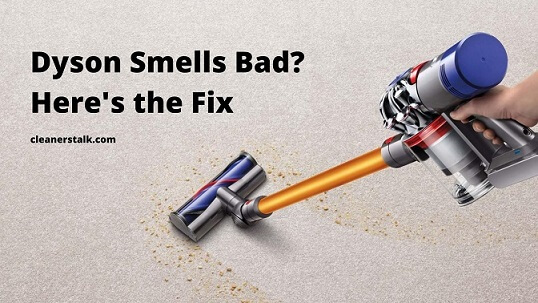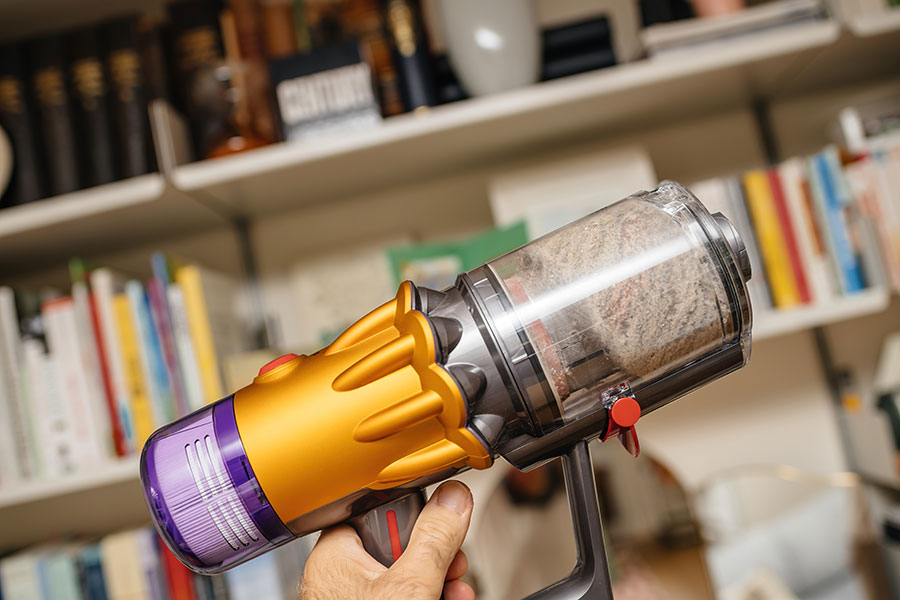
Dyson Vacuum Smell Bad? Here’s the Simple Solution
Cleaners Talk is reader-supported. This post contains affiliate links, we may earn a commission at no additional costs to you. As an Amazon Associate we earn from qualifying purchases.
Vacuuming can be a major chore, especially if you have a lot of floor space that needs cleaning. So, when you bought your Dyson stick vacuum, you probably thought it would make vacuuming a breeze.
Then, the smell hit. Now, suddenly your Dyson is giving off a foul odor that stinks up the room.
There are several reasons why your Dyson smells bad. Fortunately, most causes have pretty simple solutions. So, read on to find out how to get your Dyson back in like-new condition.
Why Dyson Vacuum Cleaner Smells Bad?
Not cleaning your Dyson vacuum cleaner is the reason why it smells. Your Dyson vacuum can produce bad odor if either the tank is dirty, the filter is dirty, the tube is dirty, the brush or roller is dirty, or your Dyson is working too hard. Make it a habit to clean your Dyson vacuum cleaner regularly to prevent it from smelling.
Reason 1: The tank is dirty
The first and most likely culprit of a smelly Dyson is a dirty tank. Although most of what you vacuum up might be dust, crumbs, and other dry things, it takes just a tiny amount of moisture to cause a musty smell. This is especially true if you haven’t emptied your tank for a while.
For example, say you happened to vacuum up wet leaves your kids tracked into the house. Then, you proceeded to let the tank sit for several days. The moisture from those leaves could mix with the other debris in your tank and cause a funky smell.

How to fix it
This is one of the most straightforward fixes for a smelly vacuum. All you have to do is clean your tank.
Now, it might take a bit of scrubbing and leg work, depending on how long the tank sat and how much moisture got in. But it’s still a pretty simple process:
- Completely empty your tank of all solid debris.
- Use a dry paper towel to scoop out any debris that might be clumped on the sides.
- Wet a paper towel with a vinegar and water solution and wipe down the inside of your tank.
- Let the tank dry completely before reattaching it to your Dyson.
If the smell was particularly strong, you might need to get into the crevices with a small scrub brush to make sure everything’s clear.
Reason 2: The filter is dirty
A dirty filter is another leading cause of a smelly Dyson vacuum. After all, the dirt, dust, and other debris you vacuum up passes through and past the filter, so it stands to reason it would be one of the top reasons your vacuum might put off a yucky smell.
If you’ve had your vacuum for a while but haven’t changed or cleaned the filter, that’s likely your problem. So, if your tank is clean, the filter should be your next stop.
How to fix it
There are two ways to address a dirty filter. You can either wash it or replace it. The filter of your Dyson vacuum cleaner is located on top of your cyclone block.
If you don’t want to shell out the money to buy a new filter just yet, you can try your hand at cleaning it first. Just make sure you follow these steps to avoid damaging your filter:
- Using cold water, wash the filter in the sink. Don’t use any soaps or detergents. Just water.
- Wring out the excess water, then repeat the process until the filter and water are clear.
- Let the filter air dry for at least 24 hours before returning it to the machine.
If your filter is damaged or simply beyond the help of cleaning, you should replace it. You should always order official parts through Dyson, so check out their website to find which filter you need, and place your order.
Reason 3: The tube is dirty

Like your tank, the tube, or stick, part of your vacuum can harbor moisture that can cause a nasty smell. If any water or other liquid gets into the tube and sticks to the sides, it could cause foul-smelling buildup. Fortunately, all you have to do to fix the problem is give the tube a good cleaning.
How to fix it
Cleaning your tube isn’t a complex process, but, as with your tank, it could take some elbow grease:
- Detach the brush and cyclone from your tube and set them aside.
- Look into the tube and check for any large obstructions. If you can reach them, try to remove them. If they’re too far down, you can use a broom handle to try to dislodge them.
- Once any obstructions are out of the way, check to see if there are any obvious signs of buildup on the inside. You’ll want to focus your cleaning on those if they exist.
- Run your tube under a hot shower or spray. If there’s built-up grime, you might want to use a garden hose with a jet function to get the gunk off.
- Let the tube dry completely before reassembling your machine. The best way to do this is to set it on its end at a slight angle so air can flow through the entire piece.
Reason 4: The brush or roller is dirty
The brush and rollers are easily the dirtiest parts of your vacuum. Not only is the roller head the first place dirt and debris touches, but it’s also where they linger. Emptying your tank each time you use the machine is a great way to keep your tank clean, but how often do you attack the part that actually touches the floor?
How to fix it
In some cases, you might be able to easily remove the debris clogging the brush without taking anything apart. However, if your brush or roller head are really jammed up, you’ll need to break out a thick coin and follow these steps:
- Disconnect the roller head from the stick.
- Using a coin, turn the cover on the side of the roller. This will allow you to remove the brush from the roller, making everything easy to clean.
- Clean the brush by removing any debris by hand. If you have a lot of hair tangled up, carefully clip it away with small scissors. Manicure scissors are best because they’re small and are less likely to accidentally snip the brush.
- Wipe out the shell with a dry cloth. Since there’s a motor in the roller head, you don’t want to use any water to clean it.
- Once you’ve cleaned up your brush and roller shell, you can reassemble the head and put it back on the stick. Then, you can go about vacuuming as usual right away.
Reason 5: Your Dyson is working too hard
All of the issues thus far have focused on foul odors caused by dirt, debris, moisture, and other things that could get sucked up into your vacuum. But there’s one smell that can cause even the most diligent cleaners to question whether they should continue using the vacuum: burning.
If your vacuum has a burnt smell when you run it, it’s likely working too hard. This could be for various reasons, but the problem might be any of the areas listed above.
How to fix it
There are two options if your Dyson smells bad like it’s burning. First, you can try to clean it. Or, if that doesn’t work, you can look into a repair.
When you smell a burning odor coming from your vacuum, cleaning it should be your first option. The likely culprit is the filter, so you could start there and work your way down:
- Remove, clean, and replace your filter following the steps outlined above. If cleaning isn’t an option, purchase a new one.
- Next, move onto your tank and tube. It’s unlikely the tank or tube will be the problem, but if you’re cleaning one area, you might as well tackle them all.
- Finally, take apart the roller head and give it a really good cleaning. A lot of times, things like hair can build up there. Not only will that cause your vacuum to work harder sucking up debris, but the constant heat will also cause the hair to get that unmistakable “burnt hair” smell. When that’s the case, simply removing the hair may remedy the issue.
If none of those options work, you should reach out to a trustworthy and certified repair person. Dyson’s are quite an investment, so if your vacuum cleaner needs more than a cleaning, you should leave any repairs to professionals to ensure the longevity of your machine.
Last Resort: Buy a new vacuum
Unfortunately, if you’ve run through every option on this list to no avail, it might be time to replace your machine. If you feel a Dyson is too expensive, consider other upright vacuum cleaner options.
That said, unless your machine is nearing retirement age, you’ll most likely be able to repair it if there’s any serious issue, like not charging for example. Newer machines will have warranties attached. All you’ll need is your proof of purchase, and Dyson might be able to take care of a repair or replacement at no cost to you.
Conclusion
Cleaning your stick vacuum is a good idea even if there isn’t a problem because it can prevent issues like those listed here from occurring. Fortunately, it doesn’t take much to address the issue of a stinky Dyson. Follow the steps outlined here, and you’ll be on your way back to vacuuming in no time.
Dyson reviews:
